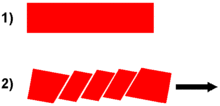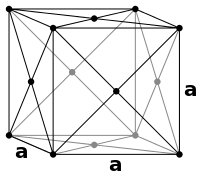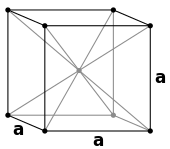Slip (materials science)

In materials science, a slip system describes the set of symmetrically identical slip planes and associated family of slip directions for which dislocation motion can easily occur and lead to plastic deformation. An external force makes parts of the crystal lattice glide along each other, changing the material's geometry. Depending on the type of lattice, different slip systems are present in the material. More specifically, slip occurs on close-packed planes (those containing the greatest number of atoms per area), and in close-packed directions (most atoms per length). The magnitude and direction of slip are represented by the Burgers vector. The picture on the right shows a schematic view of the slip mechanism. The slip planes and slip directions in a crystal have specific crystallographic forms. The slip planes are normally the planes with the highest density of atoms, i.e., those most widely spaced, and the direction of the slip is the direction in the slip plane that corresponds to one of the shortest lattice translation vectors. Often, this is the direction in which atoms are most closely spaced. A slip plane and a slip direction constitute a slip system. A critical resolved shear stress is required to initiate a slip.[1] Slip is an important mode of deformation mechanism in crystals. For metals and technically used metallic alloys it is by far the most important deformation mechanism and subject to current research in materials science.
Slip systems
Face centered cubic crystals


Slip in face centered cubic (fcc) crystals occurs along the close packed plane. Specifically, the slip plane is of type {111}, and the direction is of type <110>. In the diagram, the specific plane and direction are (111) and [110], respectively. Given the permutations of the slip plane types and direction types, fcc crystals have 12 slip systems. In the fcc lattice, the norm of the Burgers vector, b, can be calculated using the following equation:[2]
Where a is the lattice constant of the unit cell.
Body centered cubic crystals

Slip in body-centered cubic (bcc) crystals occurs along the plane of shortest Burgers vector as well; however, unlike fcc, there are no truly close-packed planes in the bcc crystal structure. Thus, a slip system in bcc requires heat to activate. Some bcc materials (e.g. α-Fe) can contain up to 48 slip systems. There are six slip planes of type {110}, each with two <111> directions (12 systems). There are 24 {123} and 12 {112} planes each with one <111> direction (36 systems, for a total of 48). While the {123} and {112} planes are not exactly identical in activation energy to {110}, they are so close in energy that for all intents and purposes they can be treated as identical. In the diagram on the right the specific slip plane and direction are (110) and [111], respectively.[2]
Hexagonal close packed crystals
Slip in hexagonal close packed (hcp) metals is much more limited than in bcc and fcc crystal structures. Usually, hcp crystal structures allow slip on the densely packed basal {0001} planes along the <1120> directions. The activation of other slip planes depends on various parameters, e.g. the c/a ratio. Since there are only 3 independent slip systems on the basal planes, for arbitrary plastic deformation additional slip or twin systems needs to be activated. This typically requires a much higher resolved shear stress and results in the brittle behavior of hcp polycrystals.
Cadmium, zinc, magnesium, titanium, and beryllium have a slip plane at {0001} and a slip direction of <1120>. This creates a total of three slip systems, depending on orientation. (Remember that a slip system is a combination of a slip plane and a slip direction) Other combinations are also possible.[3]
There are two types of dislocations in crystals that can induce slip - edge dislocations and screw dislocations. Edge dislocations have the direction of the burgers vector perpendicular to the dislocation line, while screw dislocations have the direction of the burgers vector parallel to the dislocation line. The type of dislocations generated largely depends on the direction of the applied stress, temperature and other factors. Screw dislocations can easily cross slip from one plane to another if the other slip plane contains the direction of the burgers vector.[1]
See also
References
External links
- An online tutorial on slip, explained on a promotional site for materials science at the University of Cambridge